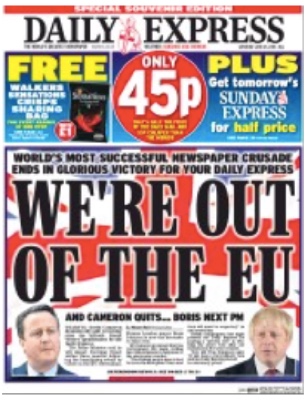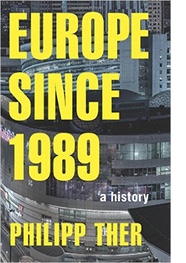How Neoliberalism – Blind Faith in Markets -- Contributed to Brexit

Britain’s decision to leave the European Union confronts it with a very uncertain future, but is also another strong signal that a period of European history has come to a close. The British plebiscite against the EU confirms the fragility of the neoliberal order that emerged in the 1980s. The first big blow came with the stock market crash of 2008–9 and the subsequent economic crisis. Some countries, like Germany, have recovered from the crisis, but southern Europe and the lower middle classes across large parts of the continent have not.
 The political responses to
neoliberalism are proving even more explosive than its economic
consequences. Populists all over Europe are exploiting the general
discontent with high unemployment, insecure and badly paid jobs for
the young, and intensifying economic competition due to free trade
and labor migrants. As Brexit shows, the old
specter of nationalism is back again, and has greater popular
appeal than the EU, which has been made the scapegoat for all sorts
of social and economic problems. The populists promise to safeguard
their ethnically defined nation from the ills of global competition,
labor competition at home, rising criminality, foreign terrorists,
and the decay of traditional national values. But their more
fundamental allure lies in the fact that they have successfully
contradicted the Thatcherite slogan “There is no alternative,”
once mocked as TINA. This antipolitical mode of argumentation was
misused to press through several major economic and social reforms,
and unfortunately even European integration and the EU project. The
Brexit campaign succeeded because it insisted there is an
alternative, even if it is detrimental to large parts of the
population and might in fact lead to the dissolution of the United
Kingdom.
The political responses to
neoliberalism are proving even more explosive than its economic
consequences. Populists all over Europe are exploiting the general
discontent with high unemployment, insecure and badly paid jobs for
the young, and intensifying economic competition due to free trade
and labor migrants. As Brexit shows, the old
specter of nationalism is back again, and has greater popular
appeal than the EU, which has been made the scapegoat for all sorts
of social and economic problems. The populists promise to safeguard
their ethnically defined nation from the ills of global competition,
labor competition at home, rising criminality, foreign terrorists,
and the decay of traditional national values. But their more
fundamental allure lies in the fact that they have successfully
contradicted the Thatcherite slogan “There is no alternative,”
once mocked as TINA. This antipolitical mode of argumentation was
misused to press through several major economic and social reforms,
and unfortunately even European integration and the EU project. The
Brexit campaign succeeded because it insisted there is an
alternative, even if it is detrimental to large parts of the
population and might in fact lead to the dissolution of the United
Kingdom.
Though the Brexit vote occurred seven years after the crisis of 2008–9, there is another connection between the two events. In several postcommunist countries, the crisis was so severe that it resulted in unprecedented mass migration. In 2015 Europe was preoccupied with the arrival of more than one million refugees from the Middle East (and blatantly failed to find a common response to this challenge) but, contrary to the popular view, this influx was considerably less than the labor migration triggered by the crisis of 2008–9. Between 2009 and 2011, Romania lost 2.4 million inhabitants, or more than 10 percent of its population; Latvia and Lithuania lost several hundred thousand, mostly through labor migration. These people left their homes not only to escape the deep recession, but also in reaction to the drastic social cuts demanded by the International Monetary Fund and its various “rescue packages.” The United Kingdom was the most important receiving country for labor migrants from Eastern Europe. This immigration helped the UK to recover economically from the crisis, but also increased the job competition for the lower middle class. The right-wing populists of the UK Independence Party (UKIP) built their campaign on popular dissatisfaction with the growing economic pressure, especially on the labor market. Will Denmark, the Netherlands, France, and other countries with strong right-wing populist movements follow the English example? The rise of Donald Trump shows that this is not merely a European problem. Such questions about the future are beyond the ambit of historians. But by analyzing the past, one might better understand the present tendency toward closed societies, as opposed to the open societies once conceptualized by Karl Popper and realized in large parts of Europe after 1989.
Another proponent of closed societies and a major external challenge for the European Union and the West at large is Vladimir Putin. Russian aggression against Ukraine has ended a long phase of peace on the continent, one that had helped to strengthen the postcommunist economies and sustain social spending in Western Europe after the end of the Cold War. The authoritarian turn in Eastern Europe is not confined to Russia; it has infected Hungary and is threatening to grip Poland. New splits have appeared not only between the East and West of Europe, but also between the North and South. Another large country and a founding member of the EU, Italy, has not yet recovered from the crisis. In fact, labor migration from Italy is on the rise, and from Greece even more so. In the long run, these imbalances and the growing economic and social gaps between countries and especially within societies are jeopardizing the achievements of European integration, such as open borders, more than the challenge posed by the refugees from the Middle East and Africa.
The only consolation in this gloomy picture is the fact that at certain moments in recent history the situation was worse. This was true in the early 1990s, when Yugoslavia fell apart in a bloody and protracted civil war, resulting in a refugee crisis even more severe than the present one. The Soviet Union and its most important successor state, the Russian Federation, were plunged into chaos, and the standard Western economic recipes did not seem to work. In fact, even the expert bets on Poland were mixed in those years: unemployment was constantly rising, social protests threatened to derail reforms, the postcommunists won the elections in 1993, and it was not clear whether the economy had already hit bottom. Moreover, the European Union was divided between further integration and enlargement, and it failed miserably to bring order to its own backyard in Yugoslavia or devise a new Marshall Plan for the Eastern neighbors knocking at its doors.
And yet nowadays commentators look back calmly at the turbulent early 1990s, and even idealize the economic reforms enacted then. This tendency shaped the self-affirming debate in the United States about the postcommunist transformation at the twenty-fifth anniversary of 1989. In 2014 a pair of American scholars writing for Foreign Affairs made the bold claim that the postcommunist states had become “normal countries.” These neoliberal success stories glossed over Russia in the 1990s, where the depression was as deep as the one in the United States in the 1930s. And one should not forget that the disintegration of Yugoslavia and of Czechoslovakia was caused in part by conflicts over whether to enact radical or gradual reforms. Even in relatively “successful” countries such as Poland, the economic reforms brought suffering to millions of people in rural and old industrial regions. The hardship experienced by transformation’s losers and disillusionment with neoliberal capitalism have created fertile ground for populist parties, authoritarian tendencies, and even neo-fascist movements. As a result of the crisis, Western Europe is now facing similar challenges.
Hence the “dual transition”—from planned to market economy and from dictatorship to democracy—that many observers in 1989–90 expected to occur did not materialize. There was no universal “end of history” resulting in liberal democracy, because capitalism, as German historian Jürgen Kocka has pointed out, can exist without democracy. This may even be true for the United States, where left- and right-wing populists are on the rise as well. All these current problems have multiple causes, but they certainly include the growing gap between rich and poor, increased pressure on the middle class, the loss of the European equivalent of the “American dream,” and the diminishing capability of states and their governments to alleviate social and economic woes.
It would be simplistic to blame neoliberalism for all these problems. Instead, this book proposes to use it as a neutral, analytical term, and to distinguish between its intellectual history, its implementation (which always depended on the given context), and its social and political consequences. But certainly the main pillars of this ideology—blind belief in the market as an adjudicator in almost all human affairs, irrational reliance on the rationality of market participants, disdain for the state as expressed in the myth of “big government,” and the uniform application of the economic recipes of the Washington Consensus (which was also passed in 1989 and shows the global dimension of this caesura)—have had grave side effects. Therefore, one cannot claim that the shock therapy came first and was followed by growth and prosperity. Such a simple causal correlation cannot be proven. Still, this does not imply that the gradualists were right: countries that tried to avoid reforms in the early 1990s, such as Romania and Ukraine, fared even worse.
The main argument of this book is that the economic performance of the postcommunist countries, including Germany after its 1990 unification, depended above all on their social capital. This also best explains Poland’s unexpected success. Due to the dysfunction of their nation’s planned economy, millions of Poles had learned how to run businesses and survive in a market economy prior to 1989. They took up the many opportunities offered by the new order. To explain this properly requires a social history perspective focusing not only on reform policies, but also on “transformation from below.” Thus, this book adds to the growing historiography on neoliberalism, which so far has concentrated on its intellectual roots and breakthrough up to the 1980s. Here, the main issue is how neoliberalism was implemented in Europe in a first wave after 1989, and in a second wave starting in the late 1990s and ending with the disaster of 2008–9 (the Eastern European bubble which burst then had some commonalities with the American real estate bubble). The impact on various societies, social groups, regions, and cities is another important topic. This impact should not be painted in somber colors only. The new order also created opportunities for certain groups within society; as in the United States, neoliberalism had a popular dimension. The comparative analysis moves from East to West, and not the other way around, as is common in the traditional, occidentalist historiography of Europe. Tony Judt has already stressed the significance of changes in the East on the West in his masterly history of postwar Europe. This book tries to continue his work in terms of time and with a stronger focus on social and economic history.